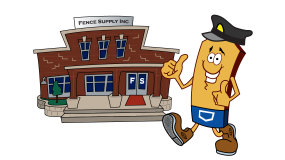Here are five common mistakes people make when choosing and building a fence for their property, and how you can avoid making them. Forewarned is forearmed!
Choosing the Wrong Kind of Fence
The process of putting up a fence can be an expensive process, so it always pays to do research and planning beforehand. The best place to start is with your city’s planning commission. Because zoning laws may affect your plan, check the regulations that pertain to fence construction in your area. Building a fence that doesn’t conform to local regulations can potentially mean having to remove your new fence.
That said, local regulations aren’t the only deciding factor when constructing a fence. Each fence style has its strengths and weaknesses, depending on your specific situation. Still, choosing a fencing system that works for you depends on what you are trying to achieve. Do you want to keep animals in, out, or both? Or, do you want a fence that just marks the boundaries of your property?
If you’re working with a certain animal, you need to know the habits of that animal. How big are they, how motivated are they to get in or out? For livestock, dairy cows and and beef cattle are the easiest to contain, with horses being a close second. Next are pigs, sheep, goats and game animals. Poultry can be especially challenging, because they can be small enough to slip under or fly over certain fences.
Even more difficult is keeping predatory animals out of your property, but simply knowing a bit about the habits of the animals can be extremely helpful. In areas prone to drought, wildlife is more likely to try to get in to your property for water. In areas without much rodent activity, a predator is more likely to come in after poultry. A fence that separates wildlife from their breeding grounds or migration trails can also offer incentive for animals to break in.
Determining the exact purpose of your fence, making sure your fence conforms to local regulations, and knowing the habits of the animals you want to keep in or out will help you determine the best fence for you.
Failing to Anchor Down Posts
A fence can only be as strong as its posts, making the posts a vitally important part of any fence. Because they are also one of the most expensive parts, it pays to take the time to choose and install fence posts carefully. A fence generally requires at least two types of post.
You will need solid posts at important spots like corners, rises, dips, and gates. These are called anchor posts, and give the fence stability and strength. These posts are generally larger and longer so they can be set further into the ground. Setting these posts incorrectly accounts for most fence failures. Anchor posts should be set deeply, properly braced, and set in concrete to ensure stability.
Line posts are the smaller posts between each anchor post. Because they’re under less stress, they don’t need to be as large or as strong as anchor posts. These posts’ prime function is to position the fence, so the taller the fence, the taller the line posts should be. Choosing the distance between line posts, which can be close as 8 inches or as far apart as 50 inches, depends on the type of fence you choose to install.
Both types of posts should be as straight as possible, because crooked posts place significant strain on the fencing material. You should also make sure that your line posts are set in a straight line between the anchor posts, to ensure stability and proper positioning.
Doing the job right means making sure anchor posts are strong, buried deep, set in concrete and braced properly. Line posts should be strong enough, tall enough, and set close enough so that your fence material is properly supported.
Improper Gate Size or Placement
Repositioning or moving gates is expensive, time-consuming and difficult, so you should take time to make sure you install them properly and in the best location. Gates should be placed in well-drained areas, out of the path of erosion. You should take foot traffic into consideration, and place gates where movement patterns are normal. Placing a gate in the corner of a livestock or garden fence encourages traffic to move along the fence line, instead of in the middle of the fenced-in space. A roadway gate should be set back far enough so that a vehicle can pull off the road while the gate is being opened.
Proper gate size is just as important. A gate designed for foot traffic should be large enough for a riding lawnmower, wheelbarrow, cart, or other wheeled tool. Four feet is usually an appropriate width. For livestock or large equipment, a 10-12 foot gate is more suitable. For vehicles, 14 feet should be wide enough, but larger farming equipment may increase your gate size. Just remember, if you have any doubts, it’s always better to have a gate that’s too big instead of too small.
A gate will get much more wear than the rest of your fence, so it’s vital to ensure it’s made from quality materials to keep the gate from sagging or warping. This also means that gate posts should be set with the same precautions and care as anchor posts.
Fencing Someone Else’s Property
When putting up a boundary fence, it is critical to know where your exact property line is, even if it means talking with a surveyor. Local restrictions can also dictate how close your fence can be built to your property line.
If you want the fence to be directly on your property line, your neighbor may be willing to share the cost and maintenance with you. You should get an agreement in writing that details the specifics. This will help guarantee the arrangement if a new neighbor moves in. In the event that an agreement can’t be reached, build your fence sufficiently inside your property line as to avoid intruding on your neighbor’s property.
Digging into Underground Utilities
Before digging in preparation for your new fence, it’s important to ensure that all underground utilities are properly marked at the surface. The depth of utility lines can vary from property to property, and each state has different regulations in place for digging. To keep from risking damage to an underground utility line, harming yourself, disrupting service, and/or incurring heavy fines, the best assurance is to call 811. While there are numerous call centers across the country you can call for underground utility information, “Call 811” is the most comprehensive and effective resource for anyone beginning a digging project. Simply dial 811 from anywhere in the country a few days prior to your digging project, and your call will be routed to your local call center. Detail your digging project to the operator, and the proper local utility companies will be notified about your intent to dig. Within a few days, they will send a locator to mark the locations of your underground utilities, so you can dig with peace of mind.



